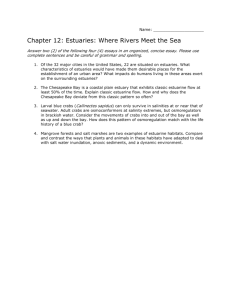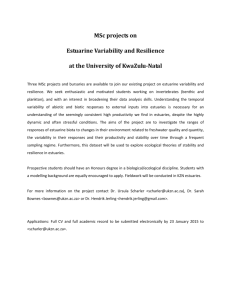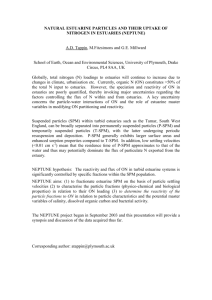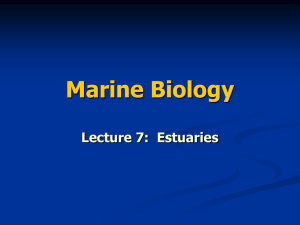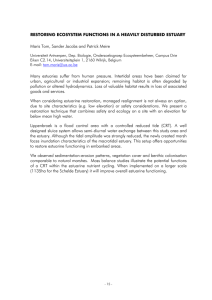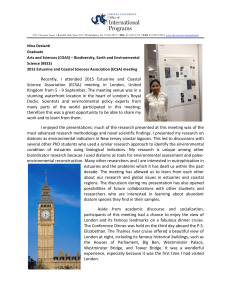MARINE ADVISORY PROGRAM 18 Oregon State University Extension Understanding
advertisement
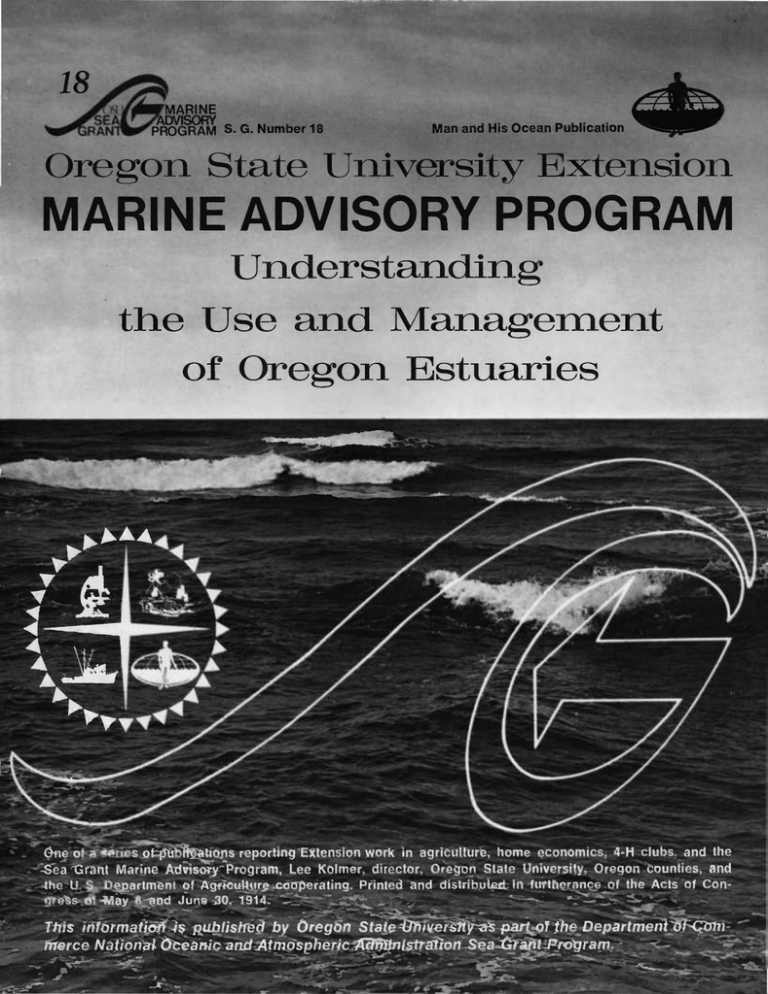
18 r SEAl JRANT ,, MARINE ADVISORY « - M . <0 PROGRAM S.G. Number 18 ^g ^^ Man and His Ocean Publication Oregon State University Extension MARINE ADVISORY PROGRAM Understanding the Use and Management of Oregon Estuaries *.AA ifc Otie of a serie's otj^aSteations reporting Extension work in agriculture, home economics, 4-H clubs, and the Sea Grant Marine Adirisory'Program, Lee Kolmer, director. Oregon State University, Oregon counties, and the U. ^Dtfiartmenl of Agftcultjue cooperating. Printed and di^tiibnted in firTthcrance_of the Acfs of Congress tfl-May 8 and June 30. 1914. . ——■ -.>^-~..:- ^-'L^ 7/7/s informatipft is pjublished by Oregon State Wnivershy as part^of the Department of Coiumerce National Oceanic and Atmospheric tfcttfibiistrsiion Sea-Grant Program. UNDERSTANDING THE USE AND MANAGEMENT OF OREGON ESTUARIES by Ken Roberts Extension Marine Economist Oregon State University Introduction Estuaries throughout the nation have been subjected to much abuse. Dredging, pollution, and other problems in estuaries have been researched by commercial organizations, universities, and a host of government agencies, The research results frequently are published in technical terms for scientific audiences, but not in a form useful to many people who have valid concerns about estuaries. Oregon State University's Marine Advisory Program is engaged in a continuing program to provide useful general information on estuaries. An earlier Marine Advisory Program publication published in cooperation with the Oregon chapter of the American Fisheries Society, Crisis in Oregon Estuaries, described the critical condition of Oregon estuaries. The purpose of this publication is to provide information about how Oregon estuaries are managed and what factors affect decisions about estuaries. Estuaries as Resources Resources - natural or man-made - are the inputs used in producing products demanded by consumers. Coal, petroleum, water, and soil are examples of natural resources. Labor and money for investment are important man-made resources used in producing products for our society. What about estuaries? Are they resources? Yes, they are a combination of natural and man-made resources that provide valuable opportunities for marine transportation, industrial plant location, commercial fisheries, sport fisheries, recreation, and even for polluters. If estuarine planning occurs, several of the opportunities can occur simultaneously. Table 1 shows estuarine areas already lost to filling operations. Note that the total estuarine acreage in Oregon is relatively limited. The table reveals an even more limited acreage of important biological habitat. The critical point is to recognize the estuaries as resources to be managed in the forthcoming effort to meet both the economic and environmental needs of Oregonians. Past Estuary Use The uses to which estuaries have been put in the past have resulted in the problems of the present. This is because estuaries are not only sites of economic activity, but also of biological activity. Much of the economic activity - tourism and commercial fishing, in particular - is directly dependent on the biological healthiness of estuaries. The cumulative effect of past economic growth now threatens much biological productivity. Thus, public agencies are confronted with conflicts that have deep historical roots. Multiple Use and Interdependence Nature consists of interdependent populations and that interdependency is clearly evident in estuaries; sea birds depend on fish and fish in turn depend on smaller fish or other marine life. Man represents another population in nature that adds further complexity. Just as there are biologic interdependencies in estuaries, so are there economic interdependencies fostered by human activities. Examples are the dependency of the paper industry on logging and of seafood processing on commercial fishing. Economic interdependencies generally can be thought of in dollar terms while the biologic interdependencies cannot. In our dollar-oriented world this means that biological factors often are ignored when biological and economic systems interact. Pollution is a good example of a situation where biologic and economic factors bear on a problem. Commercial fishermen depend in part on the quality of estuarine water which is critical to many of the important fish species. If the water becomes polluted the commercial fisherman suffers economic losses. The same dependent relationship exists between many types of marine recreation and the quality of estuaries. Figure 1 represents the various interdependencies. In many cases, man's economic well-being depends on the biological production. Recognition of this interdependency is of critical importance to resolving estuarine multiple-use problems. Table 1. Estuarine Habitat Areas Lost to Filling Operations Acres of Estuaries Total Area (Thousands) State Basic Area of Important Habitat (Thousands) ' Area of Basic Habitat Lost by Dredging and Filling (Thousands) Percent of Habitat Lost 530 133 2 1.5 11 ,023 552 574 1 .2 382 256 67.0 32 20 2 10.3 396 152 9 5.6 1 ,051 796 60 7.5 171 125 1 .6 3 ,545 2,077 65 3.1 39 15 1 6.5 1 ,406 376 1 .3 Massachusetts „. , . a/ Michigan- 207 31 2 6.5 152 152 4 2.3 Mississippi 251 76 2 2.2 12 10 1 10.0 New Jersey 778 411 54 13.1 New York 377 133 20 15.0 New York State (Great Lakes) 49 49 1 1.2 North Carolina 2 ,207 794 8 Alabama Alaska California Connecticut Delaware Florida Georgia Louisiana Maine Maryland New Hampshire Ohio^ 7 37 37 Oregon 58 20 a/ PennsylvaniaRhode Island South Carolina Texas Virginia Washington WisconsinTotal — — c/ — 1.0 b/ 1 3.5 b/ 5 5 95 15 1 6.1 428 269 4 1.6 1 ,344 1 ,670 828 68 8.2 428 2 .6 194 96 4 11 c/ 26,618- 11 7,988-/ 4.5 .0 569^ 7.1 Less than 500. Discrepancy caused by rounding. Our Nation and the Sea. Report of the Commission on Marine Science, Engineering and Resources, U.S. Government Printing Office, 1969. 2 2.0 b/ In Great Lakes only shoals (areas less than 6 feet deep) were considered as estuaries. Source: .3 Figure 1. Simplified Depiction of Estuarine Recycling Process Resource users;, Industry, Government, Estuarine Resources Wastes from \ AConsumption V' ^ Products from the Economu The resources available to an estuarine-based local economy are used to produce goods that have a market-determined value. Such goods may be purchased by anyone with money. For convenience, purchasable goods will be referred to as "dollar" goods. Goods for which a market-determined value does not exist are also produced with estuarine resources. Air quality, water quality, outdoor recreation, and scenic views have values that are not readily represented in dollar terms. The term "environmental" goods will be used to refer to these non-purchasable goods. In fact, there are some environmental goods that not only do not have a market-determined value, but which actually have a negative value. It costs money to remove these undesired goods. Such environmental goods are referred to as pollutants. The occurence of pollutants frequently generates public intervention. When this occurs it is thought that a more desirable combination of dollar and environmental goods will result with public regulation and management. There are more public policy problems arising in the management of estuaries than ever before. This is evidence that multiple-use of estuaries has officially reached the conflict state. Federal, state, and local governing units have individually and, at times, collectively used regulations and expenditure of tax money in making choices between goods with values determined in the market place (dollar goods) aad goods producted by nature (environmental goods). Decisions made by local governments, however, have the most direct and profound influence on the uses made of estuaries. The local governing unit frequently uses public investment, property taxes, land and water zoning, comprehensive planning, and special commissions to resolve multiple-use conflicts. A few of these have been used sparingly while others are in use frequently even though they are not specifically designed to resolve multiple-use conflicts. Each tool has economic ramifications and consequently each has the potential of adding further problems to estuary management programs. Local Management Tools and Public Policy The conflicts Use conflicts in estuaries are not of a single type. Some conflicts have their origins on land and others originate due to competition for estuarine water. Many of the estuarine allocation problems, whether originating on land or water, arise from both long- and short-term competition for space. In addition to this competition for space, pollution problems are prevalent. Coastal resource managers thus need to classify the source of the problems prior to trying to improve the situation. Is it competition for space or pollution that has led to a conflict? Or are both involved? The origins and results of most conflicts are so diverse that no typical conflict can be isolated for reference. At best it can be said that most conflicts facing local governing units involve decisions concerning economic growth and the environment. Both of these terms are widely used, yet much disagreement exists concerning their meaning. For clarity, the terms economic growth and envi ronment are used here in the following manner. Economic growth means increased opportunities to individuals of an area including an improved environment. The estuarine environment is conceived of as a bundle of natural resources useful to all types of plants and animals (man included). The natural resources of an estuary can be used by man to produce goods that people are willing to buy. The goods are called "dollar" goods because they can be bought. However, another use can be made of the natural resources of the estuary. Since an estuary's environment consists of resources ecologically interrelated, the resources may be used by nature to produce other resources. Clean water, for example, fosters growth of a variety of aquatic life. We know the aquatic life to be important, but we can't easily put a dollar value on its importance. For this reason when a choice between using the environment to produce other natural resources or "doillar" goods exists, people frequently choose the latter. This is basically the situation in many estuarine areas. Increasingly, local decision-makers are being asked to evaluate the uses to be made of estuarine resources. Once a decision is reached, the decision makers use the available management tools to see that the decisions are implemented. Public purchase, property taxes, comprehensive planning, special commissions, and zoning are frequently adopted management tools. A few comments concerning the tools' intended purposes, shortcomings and possible future use are presented in the following secions. The tools of management Public Purchase When public funds are used for acquiring sites where conflicts occur there may be one or more intended purposes. In some cases the purpose is to remove the possibility of conflict between users at a particular site. Consider a proposal for an industrial development on a tidal flat that yields valuable organic inputs to commercial and sport fisheries. If the development would have no detrimental effects on the fisheries when located elsewhere then the conflict is of an entirely spatial or location nature. The governing unit may consider using public funds to purchase the tidal flat and maintain it in a natural state. Additional intended purposes would be to maintain open space, guarantee public access, or assure a specific use. The first and second purposes are self-explanatory, the third requires some elaboration. Conservation of an estuary could be an avowed goal of a local governing unit. In such a case public purchase of critical sites which can then be leased to users that insure minimum output of negative environmental goods (pollutants) becomes a distinct possibility. A serious shortcoming of this tool is its general inability to favorably resolve use conflicts stemming from pollutionj/. Pollution is not the direct _]_/ It should not be surmised that each management tool in the discussion is to be evaluated as being unacceptable if it cannot resolve all use conflicts. The shortcomings of each tool are referred to simply to point out that no single local tool can be used in all cases. result of production at a particular location even though the effects may not be equal to all locations. Public purchase of parcels of land is an ineffective means by which to exclude undesired used from an entire estuarine area. This is because many pollutants originate from upstream sources. There are a few large metropolitan centers located in estuarine zones that could conceivably have the funds available for outright purchase of estuarine lands. In the majority of cases, though, the local governing unit is small and its fund-raising potential is insufficient to expect public purchase to be used frequently. The method does guarantee that a planned use will be made of a particular site but this guarantee will come at a price that many localities will be unable to pay in the future. Property Taxes The use of property tax preferential schemes to alter an undesired allocation of estuarine resources has often been used. Its implementation represents an inducement to leave land in a use that yields either a large amount of environmental goods or one that imparts a few pollutants to other estuarine users. Complete exemption from property taxes as long as the site remains in a particular use is one application of the property tax method. An additional application is the lowering of the assessed value of a particular location as long as a specified use exists at the site. The principal problem with this technique is that property taxes must be relatively high before enough inducement exists for landowners to accept the tax reduction instead of the income to be secured from sale to a publicly undesirable use. Generally the situation is one where property tax inducements to the landowner appear minimal in relation to the economic opportunities available. The fact that the property tax has developed as the primary fundraising instrument of local economies provides a basis for speculation as to its future usefulness as a means of controlling pollution and encouraging production of environmental goods. Property taxation is basically a revenuegenerating tool. Its use for managing resources requires that a local government forego revenue that frequently is difficult to secure from alternate sources. Comprehensive Planning Local governments have become increasingly involved in planning studies, designed to provide for orderly development. In reality, comprehensive planning is not a specific management tool in the same category as other discussed here. It in essence serves as a means of presenting a use plan to which the various allocation tools of a locality can be applied. A particularly desirable characteristic of planning is the open recognition of the interdependencies that exist. This alone makes it worthy of consideration in any discussion intended to help resolve estuarine use conflicts. As mentioned, implementing a local plan requires a host of regulatory tools. Unfortunately, the success of some development plans has been judged on the basis of whether or not resource management problems have been completely eliminated. It should be remembered that the purpose of comprehensive planning is not the elimination of all management problems, but to replace haphazard growth with planned use of resources. 6 Special Commissions Special commissions may be established to oversee the use of estuarine resources and to coordinate management efforts among agencies and municipalities. Special commissions are receiving increased use, particularly in coastal areas that have large estuaries. Larger estuaries are often surrounded by a number of municipalities. This alone increases the likelihood of serious multiple use conflicts. Each municipality may hesitate to act individually if it is known that the results of its improvejnent efforts will be shared by all the municipalities while it alone pays the bill for the improvements. Under the auspices of a fully authorized commission in which all estuarine interests or municipalities are represented, it is possible to overcome the problem. The San Francisco Bay Conservation and Development Commission and the Yaquina Bay Task Force are examples of the type of special commission that will be of increasing significance in the future. Such a commission results only after considerable effort is expended to gain legislative authorization. The major difficulty to be surmounted appears to be the designation of a commission's geographical authority. As has been the case with some special districts established to manage inland water resources there is a tendency for technological change to render the original limit of regulatory authority insufficient for resolving future management problems. A special commission with responsibility for the entire Oregon coast was authorized by the Oregon legislature during 1971. The Oregon Coastal Conservation and Development Commission (OCC & DC) was assigned the task of preparing a comprehensive plan for the utilization of Oregon coastal resources. This will be accomplished by a preliminary report to legislature to be followed by a final comprehensive plan. Coastal and inland residents have been appointed to the commission. In particular, there are 30 members, 24 of whom are elected officials of coastal counties, cities and port districts and six members assigned at large. In order to insure local input into the planning process the coast was divided into four districts (see Figure 2). They consist of Tillamook and Clatsop counties, Lincoln county, the coastal portions of Lane and Douglas counties, Coos and Curry counties. Local coordinating committees in each district, plus technical advisory committees are to assist OCC & DC in the planning effort. In this way a forum is available to all concerned individuals or groups. This is particularly important to the development of the final plan alone, but also a desirable means of assisting OCC & DC meet its advisory responsibility to the governor on interim measures. Zoning The most uniquely local tool is that of zoning. Zoning has been receiving increased attention as a possible tool for treating estuarine use conflicts. The original impetus for creation of zoning laws has been outlined by Haig:2/ 2/ Haig, Robert Murray, Quarterly Journal of Economics, Vol XL, May 1926, Page 433. TJ CLATSOP & TILLAMOOK LINCOLN '(A COASTAL LANE & DOUGLAS Figure 2. The four districts organized by the Oregon Coastal Conservation and Development Commission. 8 COOS & CURRY It so happens that unless social control is exercised, unless zoning is fully and skillfully applied, it is entirely possible for an individual to make for himself a dollar of profit but at the same time cause a loss of many dollars to his neighbors and to the community as a whole, so that the social result is a net loss.... zoning finds its economic justification in that it is a useful device for ensuring an approximately just distribution of costs, forcing each individual to bear his own expenses. Land use zoning has been directed toward establishment of areas within which only certain uses were to be permitted. The intention was to place those uses that brought about undesired effects into a specified area where in total the effects would be less. Current use of this technique in estuaries represents an attempt to secure such results. Two factors of the zoning approach merit study before the probability of achieving beneficial results can be determined. The first factor is the suitability of zoning for resolution of multiple use conflicts that do not involve problems of a purely spatial nature. For example, zoning would likely be successful in preventing a waste discharge outfall from occurring in close proximity to a swimming location. If it were assumed that zoning was successful in eliminating or reducing this type of problem there would still remain the problem of evaluating the results of its application to other pollution problems. An example would be its suitability to stop harmful upstream waste discharge that harm estuarine food producing processes. A second factor is the specification of the relationship between revenuegenerating property taxes and zoning. Local government reliance on property taxes as the major means of raising funds may place a constraint on conflict resolution by zoning. A local governing unit must be aware of the effect a zoning change will have on its revenues and costs. For this reason zoning decisions may be based on the effect the decision will have on the municipality': net revenue. In such a situation zoning decisions will be evaluated on the basis of which course of action will provide the largest difference between revenue generated and the cost of government service provided. The decision could then tend to be biased in favor of industrial and commerical uses of disputed sites. Private utilization of sites also might be preferred to public uses since public property does not generate income but it does require considerable public expenditure. Land and water use zoning cannot be made retroactive. If an undesirable use of certain land is already taking place, enactment of a zoning ordinance will be ineffective in remedying the situation. Zoning ordinances apply to future development on specified parcels of land and water. Because present day land values depend a great deal on this future development potential, zoning must be wisely implemented. A typical example is the individual owning land that has some development potential but before the development takes place the land is zoned as open space or recreational. In such a case the zoning ordinance has been implemented in a way that an opportunity has been taken from the landowner without compensation. Fairness is an important aspect of any management tool, including zoning. Land and water use zoning is perhaps most attractive from the standpoint of its controls on development. Much of the current utilization of estuaries is the result of historical use patterns which frequently don't match well with present day values. Zoning offers a means of preventing historical use from uncontrolled spreading within an estuary. In doing so the local populace is able to insure that determined uses exist within the estuary. The entrenched legality of zoning and its desireable feature of allowing for public hearing both seem to indicate that its usage in treating estuary conflicts will increase. Management and the Estuarine Environment Estuarine problems are highly complex. In particular, when dealing with the pollution aspect of the problems it would be helpful to realize that pollutants are merely wastes that are in the wrong place. Many high school physics texts stress the point that matter can neither be created nor destroyed. Production and consumption then are misleading words. In producing and consuming things we don't destroy matter, the processes simply change its form. Wastes or residues then are an inevitable result of production and consumption; if we remove dredge spoil from water we will be forced to dispose of it on land or by other means. Thus, since the elimination of wastes is physically impossible they must be neutralized and then placed in the environment or put in places where the least environmental harm is encountered. Refer again to Figure 1 to demonstrate this concept. Figure 1 indicates that recycling is and always has been a part of our lives. Starting in the upper left of the diagram, it can be seen that the estuary provides resources that are then used by groups and individuals to produce the products needed by society. Those products find their way to outlets prior to reaching the consumer. Note that the economy also produces things which people don't desire and are thus put into the environment as wastes. The products that people purchased are not completely used, some wastes exist after consumption. The wastes are capable of causing the environment to "short-circuit" with the result that estuarine resources are less plentiful or of poorer quality. The idea of recycling then is new only to man in the marine environment. Recycling always has been a natural, not man-made process. The task is to control the magnitude and location of the leftovers (wastes) from man's production and consumption activities in this natural process. The public in general and estuary managers in particular face the difficult task of applying management tools to such complex situations. SUMMARY Estuaries are resources of the Oregon Coastal area because they are productive. Resources by their very nature often need to be closely supervised. Since estuaries are capable of producing many different products or goods there is a need for imaginative planning of their future. Most uses made of estuaries are interdependent. We hope management efforts will decrease the number of occasions on which the interdependent uses of the estuaries also become incompatible, the estuary will suffer. The task is not to eliminate all estuarine problems, but instead to reduce the number of conflicts that reach the crisis stage. 10

